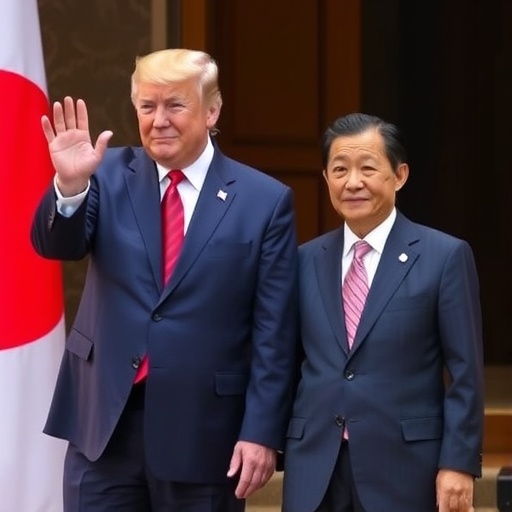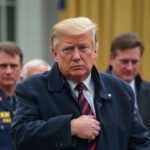Trump Arrives in Japan for High-Stakes Summit with New PM Takaichi: Bolstering U.S.-Japan Alliance Amid Rising Tensions
In a move that underscores America’s renewed commitment to its Pacific allies, President Donald Trump touched down in Tokyo on Monday, marking the start of a pivotal three-day visit to Japan. This trip, his first official overseas journey since assuming office in his second term, sets the stage for a crucial bilateral summit with Japan’s newly appointed Prime Minister Sanae Takaichi on Tuesday. Amid escalating regional security threats from North Korea’s missile tests and China’s assertive maneuvers in the South China Sea, the leaders are poised to deepen the U.S.-Japan alliance, a cornerstone of stability in the Asia-Pacific.
- Trump’s Tokyo Landing: Reviving ‘America First’ Diplomacy in Asia
- Takaichi’s Rise: From Policy Hawk to Japan’s New Face in Global Affairs
- Regional Shadows: North Korea, China, and ASEAN’s Stake in the Alliance
- Summit Spotlight: Defense Pacts, Trade Deals, and Cultural Exchanges
- Looking Ahead: Lasting Impacts of the Trump-Takaichi Partnership
Trump‘s arrival at Haneda International Airport was met with a subdued yet symbolic welcome, featuring a honor guard and brief remarks from Japanese Foreign Minister Yoshimasa Hayashi. “This visit reaffirms the unbreakable bond between our two nations,” Hayashi stated, highlighting the timing’s significance just weeks after Takaichi’s unexpected rise to power following a snap election. The alliance, forged in the ashes of World War II and tested through decades of Cold War dynamics, now faces its most complex challenges yet, with implications rippling across ASEAN nations and beyond.
The itinerary promises not just diplomatic handshakes but substantive discussions on defense cooperation, trade imbalances, and countering authoritarian influences. As Trump steps into this role once more, his ‘America First’ doctrine will intersect with Japan’s evolving security posture under Takaichi, a conservative firebrand known for her hawkish views on regional threats. This meeting could redefine alliances in an era of geopolitical flux, drawing keen interest from global markets and security analysts alike.
Trump’s Tokyo Landing: Reviving ‘America First’ Diplomacy in Asia
President Trump’s motorcade rolled through Tokyo’s bustling streets shortly after noon local time, a stark reminder of his previous 2017 visit that blended state dinners with golf outings at Kasumigaseki Country Club. But this 2025 iteration carries heavier stakes. No longer the brash outsider, Trump returns as a seasoned leader, his second administration buoyed by domestic wins but pressured by international flashpoints. Sources close to the White House describe the trip as a “strategic reset,” aimed at countering perceptions of U.S. withdrawal from Asia—a narrative that gained traction during the prior administration’s focus on domestic recovery.
Japan, Trump’s host, is navigating its own political earthquake. Sanae Takaichi, a 63-year-old former defense minister with deep ties to the Liberal Democratic Party’s right wing, ascended to the premiership after ousting her predecessor in a party coup last month. Her appointment has electrified conservative circles, with Takaichi vowing to “fortify Japan’s defenses without apology.” In a pre-visit interview with NHK, she emphasized, “The U.S.-Japan alliance is our shield against uncertainty; under my leadership, it will only grow stronger.” This rhetoric aligns seamlessly with Trump’s worldview, promising a rapport that eluded his first-term dealings with more dovish Japanese leaders.
Statistically, the alliance’s vitality is evident: U.S. forces stationed in Japan number over 54,000, contributing $2.5 billion annually to the local economy, according to Pentagon figures. Yet, tensions simmer over burden-sharing, with Trump historically pressing Tokyo to hike defense spending beyond the current 1% of GDP. Recent polls by the Asahi Shimbun show 72% of Japanese citizens support the alliance, up from 65% in 2020, reflecting growing alarm over North Korea’s 2024 barrage of 50+ missile launches and China’s gray-zone tactics near the Senkaku Islands.
The visit’s optics are meticulously crafted. Trump is scheduled for a wreath-laying at the Yasukuni Shrine—a site fraught with historical controversy—signaling respect for Japan’s war dead while navigating sensitivities with China and South Korea. Diplomatic observers note this as a bold stroke, potentially irking Beijing but solidifying ties with Takaichi’s nationalist base.
Takaichi’s Rise: From Policy Hawk to Japan’s New Face in Global Affairs
Sanae Takaichi’s journey to the prime ministership reads like a thriller plot: a trailblazing female politician in a male-dominated arena, she clinched victory through a blend of charisma, policy savvy, and opportune timing. Appointed just 45 days ago after the LDP’s internal shakeup, Takaichi brings a resume stacked with national security credentials. As internal affairs minister in 2014, she championed revisions to Japan’s pacifist constitution, arguing for a more proactive military role—a stance that resonates with Trump’s calls for allied contributions to regional stability.
Her meeting with Trump isn’t mere protocol; it’s a litmus test for synergy. Takaichi has publicly praised Trump’s deal-making prowess, tweeting last week, “President Trump’s vision for fair alliances will invigorate U.S.-Japan ties.” This warmth contrasts with the frosty exchanges during Trump’s first term, when trade tariffs strained relations. Now, with Japan’s economy rebounding—GDP growth hit 1.8% in Q4 2024, per IMF data—the stage is set for collaborative wins.
Behind the scenes, preparations have been intense. A joint working group, comprising U.S. National Security Advisor Jake Sullivan and Japanese counterparts, hashed out agendas over virtual sessions since November. Key focuses include joint exercises in the East China Sea and intelligence-sharing on cyber threats, where alliance protocols have thwarted at least 15 major hacks since 2022, according to shared briefings. Takaichi’s emphasis on technological sovereignty—evident in her push for domestic semiconductor production—aligns with Trump’s CHIPS Act extensions, potentially unlocking billions in joint investments.
Critics, however, warn of overreach. Opposition leader Yoshihiko Noda cautioned in a Diet speech, “Takaichi’s fervor must not drag Japan into unnecessary conflicts.” Yet, with public approval for her at 58% (Yomiuri poll), the momentum favors bold diplomacy. This summit could cement Takaichi as a global player, much like her mentor Shinzo Abe, whose 2016-2020 rapport with Trump yielded the QUAD framework’s revival.
Regional Shadows: North Korea, China, and ASEAN’s Stake in the Alliance
The U.S.-Japan alliance doesn’t exist in a vacuum; it’s the linchpin amid a tinderbox of threats. North Korea’s Kim Jong-un regime, emboldened by Russian tech transfers, conducted its most provocative tests in years, including a hypersonic missile overflight of Japanese airspace on December 15, 2024. Pyongyang’s arsenal now boasts over 50 nuclear warheads, per South Korean intelligence, prompting urgent calls for enhanced missile defenses—a topic topping Tuesday’s agenda.
China looms larger still. Beijing’s claims over Taiwan and the South China Sea have militarized alliances across the region. In 2024 alone, Chinese vessels intruded Japanese waters 342 times, a 20% spike from the prior year, as reported by the Japan Coast Guard. Trump’s visit signals a hardline response: expect announcements on bolstering the U.S. Seventh Fleet’s presence, with Japan contributing Aegis-equipped destroyers. “We won’t let aggressors rewrite the map,” a senior U.S. official told Reuters anonymously, echoing Trump’s past “fire and fury” rhetoric.
ASEAN nations watch closely, their neutrality strained by economic dependencies on China—trade volumes hit $1 trillion in 2024, per ASEAN Secretariat stats—yet security pacts with the U.S. beckon. Philippines President Ferdinand Marcos Jr. voiced support for the summit, stating, “A robust U.S.-Japan alliance safeguards us all from coercion.” Vietnam and Indonesia, key ASEAN players, have ramped up U.S. military access, with joint patrols up 30% since 2023. Takaichi’s outreach to ASEAN, including a proposed Tokyo summit next year, positions Japan as a bridge, mitigating fears of a bifurcated Asia.
Environmental and economic threads weave in too. Discussions will touch on supply chain resilience, vital as Japan’s auto giants like Toyota source 40% of parts from ASEAN amid U.S.-China decoupling. Trump’s tariffs on Chinese EVs could redirect investments to Japan, fostering a “friend-shoring” boom projected to add $500 billion to allied GDPs by 2030, according to Brookings Institution analysis.
Summit Spotlight: Defense Pacts, Trade Deals, and Cultural Exchanges
Tuesday’s summit at the Akasaka Palace will unfold over four hours, blending private talks with a joint presser. Defense tops the bill: extensions to the 1960 U.S.-Japan Security Treaty could include co-development of next-gen fighters, building on the $23 billion F-35 program. Trump, ever the negotiator, seeks Japan’s commitment to 2% GDP defense spending by 2027, up from 1.3% today—a goal Takaichi endorses, allocating ¥8.7 trillion ($58 billion) in her inaugural budget.
Trade won’t lag. Bilateral flows reached $300 billion in 2024, but imbalances persist—U.S. deficit with Japan at $70 billion. Expect tweaks to the 2019 U.S.-Japan Trade Agreement, perhaps easing beef imports or digital taxes, with Trump quipping in a Fox News preview, “Japan makes great cars; we’ll make sure they make them with American steel too.” Cultural diplomacy adds flair: a state dinner featuring wagyu and sake will host 200 dignitaries, followed by Trump’s address to the Diet on Wednesday.
Beyond bilaterals, side meetings loom. Trump will confer with ASEAN ambassadors, pushing a “free and open Indo-Pacific”—a phrase coined under his first term. Stats underscore urgency: 60% of global maritime trade transits the South China Sea, vulnerable to disruptions that could spike oil prices 25%, warns the World Bank.
Women’s empowerment angles emerge, with Takaichi hosting a forum on gender in STEM, nodding to her barrier-breaking role. U.S. First Lady Melania Trump, joining for the final day, will spotlight initiatives aiding Japanese women in tech, a sector where female participation lags at 15%.
Looking Ahead: Lasting Impacts of the Trump-Takaichi Partnership
As Trump’s visit extends into Wednesday with factory tours in Yokohama and a bilateral lunch, the ripple effects promise longevity. A joint declaration on alliance enhancement could spawn new protocols, like real-time data sharing on hypersonic threats, fortifying deterrence. Economically, pacts might unlock $100 billion in investments over five years, per U.S. Trade Representative estimates, boosting jobs from Detroit to Osaka.
Regionally, ASEAN integration deepens: Takaichi’s vision includes trilateral U.S.-Japan-ASEAN drills by 2026, addressing non-traditional threats like climate-induced migrations affecting 10 million in Southeast Asia annually, according to UN projections. Trump’s personal touch—rumored golf with Takaichi—could humanize the alliance, echoing his bond with Abe.
Challenges persist: domestic politics in both nations demand results, with midterm pressures in the U.S. and LDP cohesion tests in Japan. Yet, if the summit delivers, it heralds a fortified front against volatility. As Trump departs Thursday, the U.S.-Japan alliance emerges not just resilient, but reinvigorated— a beacon for ASEAN and the free world amid gathering storms.









